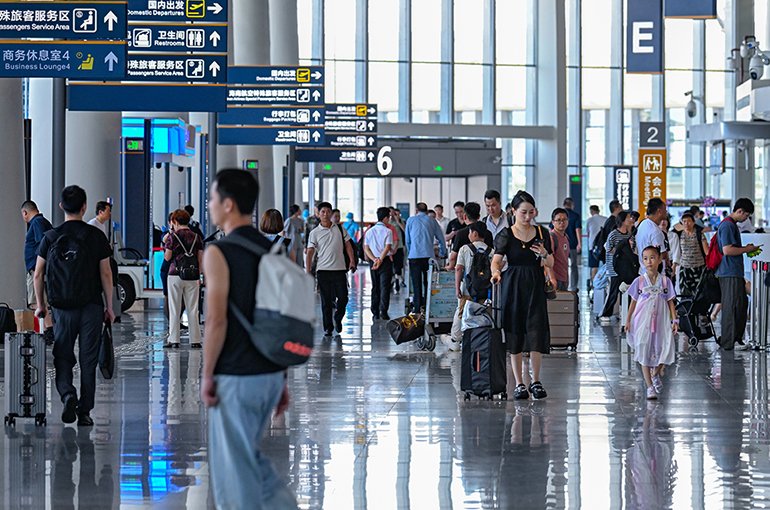Flight Buzz
Traveller’s seatbelt trick for ‘sleeping like a baby’ on long flights prompts warning: ‘Scared’

There are so many amazing things about taking an overseas holiday. You get to experience new and intriguing places, try new cuisines, see sights you might be familiar with from movies and hopefully switch off from the demands of life for a while.
Although Aussies love to travel and are known as a fairly intrepid bunch, it cannot be denied that taking an international trip from Down Under to pretty much anywhere can be torturous because it takes so damn long! And, if you are in an economy seat, it can feel like even longer.
It’s no wonder that travellers will go to the ends of the earth trying to find ways to make long-haul flights bearable and to find travel hacks that promise a decent stretch of sleep.
However, after one tourist shared a controversial travel hack for sleeping on flights, her followers expressed concerns about the trick’s safety, and a vascular surgeon tells Yahoo Lifestyle that she would not recommend it.
In a TikTok that has been viewed 560k times, Lindsay (@linzi_who) demonstrates the unusual position she found that helped her get some rest on a flight.
RELATED:
Traveller’s flight sleep hack divides
“Now this is the travel hack we all need to know,” she says in the clip. “Extend the seatbelt as far as you can, put your legs up, wrap it around your ankles, plug it in and look nice and tight. Then I turn sideways, put my head against the back of the chair, and honestly, I slept like a baby.”
While Lindsay says the hack “made sleeping on the plane so much easier”, the video attracted more than 200 comments from people who saw nothing but issues.
“I’m 5ft 11, no chance I could do that lol,” one person said while someone else said it wouldn’t work for them as they are 6’2.
“I mean that would never work for us plus-sized girlies 😩😩😩,” another person lamented.
“My knees after that would a hundred per cent not stretch out without a cry of pain and help 💀😂,” someone else added.
“Hard to do when you have your 9-month-old on your lap 😂😂,” was another comment.
Another person said that they “got told off” when they attempted the trick.
Other travellers were more open to the idea, with a couple of them saying they intended to try the trick themselves on their next flight.
“I do this without turning to the side, and it was the most comfortable way I’ve found on long-haul flights,” one person commented.
Travellers concerned about risks of flight hack
There were also plenty of comments from people who said that they would be too concerned about deep vein thrombosis (DVT) to attempt the seat hack.
DVTs (blood clots) can occur when people sit still for long periods of time, as this slows down blood flow in the legs. A lack of movement greatly increases the chances of a clot forming, and if that blood clot breaks loose, it can travel through the bloodstream to the lungs, causing a blockage called a pulmonary embolism, which can be life-threatening.
“I’d be too scared of DVT,” one said.
“Yeah, like you don’t higher the risk of a blood clot when you travel like this. Good luck,” added another.
“Enjoy your DVT,” a third wrote while someone else commented, “DVT… 🤔 You shouldn’t sit like that on an aeroplane.”
Expert’s warning over dangerous seat hack
Dr Pecky De Silva, a vascular surgeon and Councillor at the Royal Australasian College of Surgeons, tells Yahoo Lifestyle that the detractors of the travel hack are absolutely right and that staying in that position could indeed be dangerous.
“The practice shown on the video would increase your risk of deep venous thrombosis because of the immobility of the limbs held in place by the safety belt, but also because of the position of the legs, causing compression of the major deep vein behind the knee,” she tells us.
And, replying to the many viewers of the TikTok who wondered about the safety of the trick during turbulence, Dr De Silva says she agrees with them too.
“My other concern would be that during severe turbulence, the safety belt wouldn’t keep you safe, and you would be at risk of flying up and hitting your head,” she says. “Altogether, I would definitely be advising my patients against this practice.”
How to prevent DVT on long haul flights
If you are lucky enough to have an international flight coming up, there are several things you can do to minimise the risk of DVT.
SHOP:
For starters, you should wear comfortable and loose fitting clothes (pretty standard attire for a long flight anyway) so you can move freely. However, wearing compression socks is a great idea too – particularly for anyone who is at a higher risk of clots, such as women on the birth control pill.
And, although it can be so tempting to relax with a few glasses of wine during your flight (you are on holiday, after all!), it is recommended that caffeine, alcohol and sleeping pills be avoided. Instead, try to drink plenty of water which will keep you hydrated and could even help to minimise jet lag.
And, of course, it’s important to try to get up and move around as much as possible during the flight to increase circulation and prevent muscle soreness and stiffness.
Flight Buzz
Malaysia Airlines Expands Connectivity to Trivandrum with Daily Flights by December 2025

India, 04 August 2025 – Following encouraging load factors and sustained demand on its Trivandrum – Kuala Lumpur route, Malaysia Airlines is set to further expand its presence in South India by increasing frequencies to the city. Beginning 12 September 2025, the airline will introduce a fifth weekly service, with daily operations to commence from 1 December 2025. Tickets for the new frequencies will be available with immediate effect. This marks a significant step forward since the route’s launch in November 2023, which initially operated twice weekly before increasing to four times weekly in April 2024.
The airline has also partnered with Kerala Tourism under “Look East” initiative, launched in Trivandrum to strengthen travel ties between East Asia and Kerala.
The increase in frequency reaffirms Malaysia Airlines’ commitment to the Indian market by offering travellers greater flexibility and convenience, while enhancing connectivity between India and Malaysia. Through its hub in Kuala Lumpur, the airline continues to strengthen its role as the gateway to Asia and beyond.
Dersenish Aresandiran, Chief Commercial Officer of Airlines from Malaysia Aviation Group said, “India remains a key focus market for Malaysia Airlines, and this frequency increase reaffirms our dedication to meeting the growing demand for air travel from South India. With daily flights to Trivandrum, we are well-positioned to offer greater flexibility and convenience for both business and leisure travellers, while supporting trade and tourism flows between our two countries.”
Malaysia Airlines currently operates 76 weekly flights across ten key cities in India including Delhi, Mumbai, Bengaluru, Chennai, Hyderabad, Kochi, Ahmedabad, Amritsar, and Trivandrum. With the new additions, this number will increase to 77 weekly flights by December 2025.
Passengers flying from India to Malaysia can also take advantage of Malaysia Airlines’ Bonus Side Trip (BST) programme, which offers a complimentary side trip to one of seven domestic destinations within Malaysia. This value-added offering allows international travellers to explore more of Malaysia’s unique culture, nature, and heritage—all within a single itinerary.
For more information or to book, visit malaysiaairlines.com or download the mobile app for the latest deals and promotions.
Flight Buzz
China’s Air Travel Picks Up in July, But Ticket Prices Stay Low

(Yicai) Aug. 4 — China’s civil aviation sector saw a slight uptick in July amid the summer travel rush, but ticket prices are still under pressure, with the average economy fare tumbling 7.5 percent from a year earlier, according to the latest data.
The number of passengers that flew on domestic routes in July climbed 3 percent from a year earlier to 60.3 million, according to statistics from state-backed flight information provider Air Travel Navigator. While passenger numbers on international routes surged 10 percent to 7.7 million.
Ticket sales to tourist hotspots saw much faster growth. Bookings to popular cities such as Xining in western Qinghai province as well as Lijiang and Dali in southwestern Yunnan province jumped more than 13 percent year on year, while bookings to several cities in Xinjiang Uyghur Autonomous Region surged by over 10 percent, Zhao Nan, general manager of the industry development department at Air Travel Navigator, told Yicai.
The summer travel boom this year was not as strong as expected, a marketing executive at an airline said. “The first part of July was not bad, but after the middle of the month passenger loads began to decline and it became difficult to raise prices.”
The average price of an economy class ticket on a domestic route slumped 7.5 percent in July from a year earlier to CNY840 (USD117), including fuel surcharges, according to data from flight tracking platform Flight Manager. This is also a 5 percent drop from the same period in 2019, the year before the pandemic.
Of the 20 most popular domestic routes, only the Hangzhou-Shenzhen route saw fares go up, while prices on the rest declined to various degrees. Fares on 11 of these, including the Chongqing to Beijing route, plunged by more than 10 percent from a year ago.
The July-August summer travel season is usually one of the most profitable times of the year for airlines, second only to the Chinese New Year travel rush. It is also a key time for airlines to add international flights. However, this year, international flight volumes are only back to 89.1 percent of 2019 levels, according to the latest statistics from Flight Manager.
The pattern of international routes flown by Chinese airlines has changed significantly since before the pandemic, industry insiders told Yicai. Flights to and from Central Asia, Africa and the Middle East now account for over 70 percent of international flights, while traditional long-haul routes to Europe and the United States, remain well below pre-pandemic levels due to reciprocal air rights restrictions.
In terms of the most popular international destinations, the number of flights to Japan, Malaysia, Singapore, Vietnam, the United Kingdom, the United Arab Emirates, Kazakhstan and Laos in July exceeded the same period in 2019, according to Flight Manager. However, flights to Thailand are only at 54.6 percent of 2019 levels, while those to Cambodia and the Philippines are still less than 50 percent, and flights to North America are under 30 percent of what they were before the pandemic.
Editors: Tang Shihua, Kim Taylor
Flight Buzz
Thiruvananthapuram Eyes Direct Flights to Thailand, Vietnam

Thiruvananthapuram International Airport is preparing to launch direct flights to Thailand and Vietnam in response to increasing demand from travellers. The move is set to significantly improve connectivity, reduce travel time, and enhance access to two of Southeast Asia’s most popular destinations.
Currently, passengers must take connecting flights via hubs such as Kuala Lumpur or Singapore, often adding over 10 hours to their journey. The proposed direct flights—reducing travel time to approximately five hours—will not only streamline transit but also encourage greater tourism and business activity between Kerala and Southeast Asia.
Airport authorities have confirmed they are in advanced discussions with multiple airlines and relevant regulatory bodies. Several carriers have shown interest in expanding operations from the city, including launching new routes and increasing flight frequencies to Thailand and Vietnam. Tour operators report growing interest from travellers exploring the region, especially to Ho Chi Minh City, with many combining trips to Vietnam and Cambodia.
This initiative is part of a broader strategy to enhance Thiruvananthapuram’s status as a major international hub. The airport currently offers direct flights to destinations including Dubai, Singapore, Kuala Lumpur, Doha, Sharjah, Muscat, Abu Dhabi, Dammam, and the Maldives. The addition of Southeast Asian routes will further elevate its network reach.
With rising international passenger volumes, airport authorities are investing in service upgrades and infrastructure expansion. Passenger traffic is expected to grow from current levels to approximately 3.96 million by 2030, 5.32 million by 2040, and 11.45 million by 2070.
Improved air links are also expected to generate broader economic benefits. Increased international tourist arrivals will support the local economy through growth in hospitality, retail, logistics, and manufacturing sectors. Enhanced trade ties with Southeast Asia could also attract investment in technology and industrial development.
This connectivity initiative aligns with wider regional development goals and positions Thiruvananthapuram as a key gateway for international movement of people and goods. As Southeast Asia continues to emerge as a global economic powerhouse, stronger air links will be essential for sustaining growth and prosperity across the region.
-

 Brand Stories2 weeks ago
Brand Stories2 weeks agoBloom Hotels: A Modern Vision of Hospitality Redefining Travel
-

 Brand Stories1 week ago
Brand Stories1 week agoCheQin.ai sets a new standard for hotel booking with its AI capabilities: empowering travellers to bargain, choose the best, and book with clarity.
-

 Destinations & Things To Do2 weeks ago
Destinations & Things To Do2 weeks agoUntouched Destinations: Stunning Hidden Gems You Must Visit
-

 Destinations & Things To Do1 week ago
Destinations & Things To Do1 week agoThis Hidden Beach in India Glows at Night-But Only in One Secret Season
-

 AI in Travel2 weeks ago
AI in Travel2 weeks agoAI Travel Revolution: Must-Have Guide to the Best Experience
-

 Brand Stories1 month ago
Brand Stories1 month agoVoice AI Startup ElevenLabs Plans to Add Hubs Around the World
-

 Brand Stories3 weeks ago
Brand Stories3 weeks agoHow Elon Musk’s rogue Grok chatbot became a cautionary AI tale
-

 Asia Travel Pulse1 month ago
Asia Travel Pulse1 month agoLooking For Adventure In Asia? Here Are 7 Epic Destinations You Need To Experience At Least Once – Zee News
-

 AI in Travel1 month ago
AI in Travel1 month ago‘Will AI take my job?’ A trip to a Beijing fortune-telling bar to see what lies ahead | China
-

 Brand Stories2 weeks ago
Brand Stories2 weeks agoContactless Hospitality: Why Remote Management Technology Is Key to Seamless Guest Experiences



You must be logged in to post a comment Login